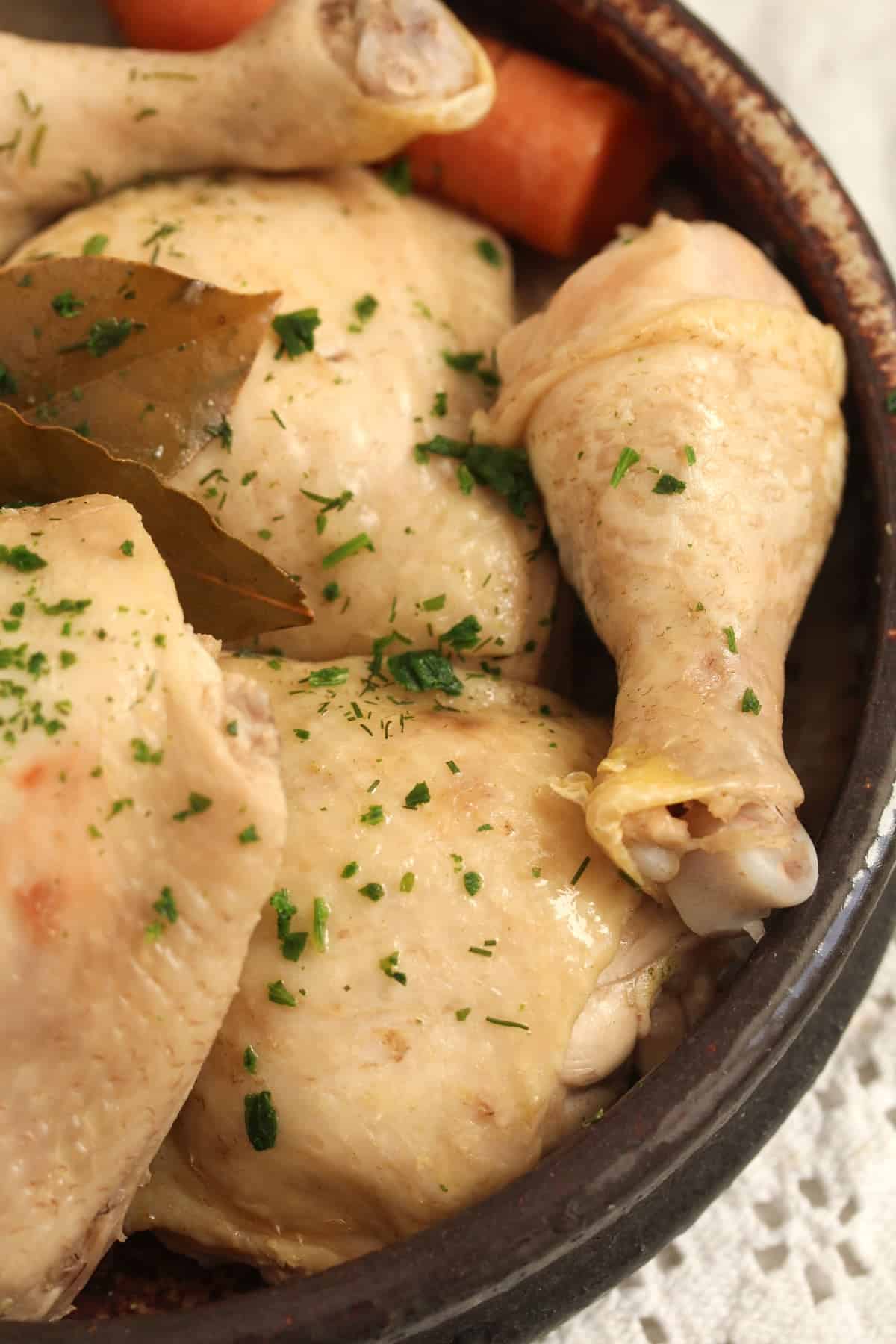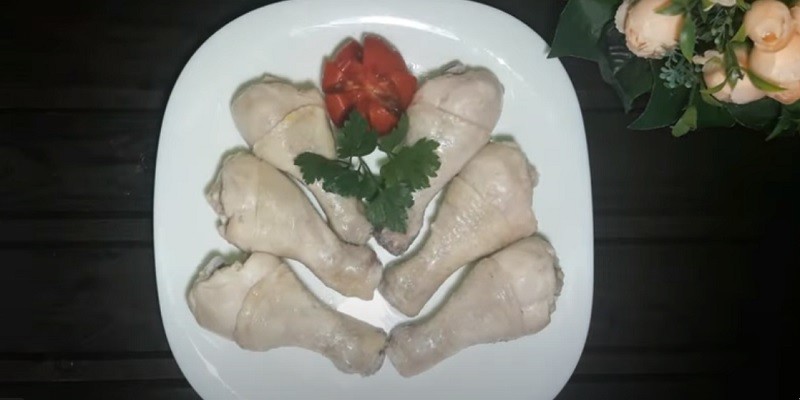Last Updated on April 23, 2025 by Pauline G. Carter
Boil chicken legs for 30 to 40 minutes, until fully cooked. Ensure the internal temperature reaches 165°F (75°C).
Cooking chicken legs properly is crucial for both safety and flavor. Boiling is a simple, no-fuss method that tenderizes the meat while keeping it juicy. This method is perfect for pre-cooking chicken for further grilling or shredding for recipes. It’s also a great starting point for creating rich soups and stews.
Using a thermometer can help prevent overcooking, ensuring the chicken legs remain succulent and delicious. As with any poultry, practicing food safety by verifying the internal temperature is a must to avoid foodborne illnesses.
Perfectly Boiling Chicken Legs
Welcome to the ultimate guide on Perfectly Boiling Chicken Legs. Whether you’re a seasoned chef or a kitchen newbie, knowing how to boil chicken legs properly is a fundamental skill that will elevate your home cooking. Boiling is a simple, yet effective method for cooking juicy, flavorful chicken legs. The secret lies in the details: understanding the basics, perfecting the timing, and considering the size and type of chicken. Let’s dive into each of these aspects to ensure you achieve perfectly boiled chicken legs every time.Understanding the basics of boiling chicken
The Basics Of Boiling Chicken
Boiling chicken might seem straightforward, but several key factors ensure optimal results. Begin by placing chicken legs in a large pot and cover them with water or broth for added flavor. Add a pinch of salt, herbs, and spices as desired to infuse the meat with aromas and tastes.
Bring the water to a rolling boil over high heat and then reduce to a simmer. This slower cooking process allows the heat to penetrate deeply without toughening the meat.Importance of timing for texture and flavor
Importance Of Timing For Texture And Flavor
The cooking time is crucial for achieving the perfect texture and flavor. Chicken legs typically require 30 to 40 minutes of boiling to become fully cooked and tender. An undercooked chicken not only poses health risks but also lacks the pleasing texture we all love. Overcooked chicken, on the other hand, can become dry and tough.
Use a meat thermometer to check the internal temperature, which should reach 165°F (75°C) to ensure the chicken is safely cooked and ready to serve.Role of chicken size and type
Role Of Chicken Size And Type
Not all chicken legs are created equal. Size and type play a significant role in determining the boiling time. Smaller drumsticks may require less time, while larger ones or those with thighs attached will need more.
- Small drumsticks: 25-30 minutes
- Large drumsticks: 35-45 minutes
- Drumsticks with thighs: 40-50 minutes
Organic or free-range chicken legs can also have varying cooking times due to their density and muscle structure. Adjust your timing accordingly and always confirm doneness with a meat thermometer.
Preparing Your Chicken Legs
Embarking on the culinary quest of boiling chicken legs, preparation is key to ensuring succulent and flavorful results. This phase is the bedrock of a delightful meal, as it sets the stage for texture, taste, and overall palatability. Before the question of how long to boil chicken legs can be answered, diving into the fundamentals of preparation is essential. So, aprons on, and let’s get the chicken legs ready for their hot water plunge!
Cleaning And Seasoning Suggestions
- Rinse thoroughly: Begin by rinsing the chicken legs under cold water to wash away residual blood or bone fragments.
- Pat dry: Use paper towels to pat the chicken legs dry. Excess moisture should be removed to ensure seasonings adhere properly.
- Marinate or dry rub: Opt for either a flavorful marinade or a concoction of dry spices. For a classic seasoning, combine salt, garlic powder, paprika, and black pepper.
Tips On Adding Flavors During Boiling
Infusing the water with aromatics and seasonings enhances the chicken’s flavor from the inside out. Consider the following:
- Bouillon cubes or chicken stock for a rich, savory base.
- Herbs like rosemary, thyme, and bay leaves introduce earthy notes.
- Garlic, onion, and celery create a traditional mirepoix for depth.
- Acidic elements such as lemon juice can tenderize and add zest.
Pre-boil Prep Work Essentials
| Essential | Description |
|---|---|
| Large Pot | Select a pot ample enough to comfortably fit the chicken legs and enough water to cover them by an inch. |
| Quality Ingredients | Ensure all spices, herbs, and vegetables are fresh and of the highest quality for the best flavor. |
| Proper Timing | Set aside enough time for seasoning or marinating, as well as for the actual boiling process. |
How Long To Boil Chicken Legs?
Perfectly boiling chicken legs is a simple yet delicate process that results in tender and flavorful meat, but it’s a question that often plagues home cooks: How long should you boil your chicken legs for optimum results? The answer isn’t one-size-fits-all. It depends on several factors, from the size of the legs to the desired doneness. Let’s break down the key elements determining the perfect boiling time for your chicken legs to ensure a succulent meal every time.
Factors Affecting Boiling Times
The boiling time of chicken legs can be influenced by several key factors:
- Size and Weight: Larger chicken legs require more time to cook through completely.
- Starting Temperature: Legs taken straight from the fridge will take longer to boil than those at room temperature.
- Altitude: Boiling points change with altitude, which in turn can affect cooking times.
- Desired Doneness: Some recipes call for slightly firmer meat, while others require fall-off-the-bone tenderness.
Boiling Times For Different Sizes
Boiling times for chicken legs can vary depending on their size. Here’s a quick guide to help you gauge the right cooking time:
| Size | Boiling Time |
|---|---|
| Small (4-5 oz) | 30-40 minutes |
| Medium (6-8 oz) | 40-50 minutes |
| Large (8 oz or more) | 50-60 minutes |
Keep in mind that these are approximate times and that the actual time may vary based on the mentioned factors. Always ensure you are monitoring the pot to avoid overcooking, which can lead to dry and tough meat.
Testing For Doneness
To make sure your chicken legs are not only safe to eat but also deliciously tender, you’ll need to test for doneness:
- Insert a meat thermometer into the thickest part of the leg without touching the bone. Chicken is safe to eat when it reaches an internal temperature of 165°F (75°C).
- Examine the juices running from the chicken; they should be clear and not pink or red.
- Check the meat’s texture; it should be firm, not rubbery or soft.
- Pierce the chicken with a fork. If it goes in easily and the meat starts to fall off the bone, the chicken legs are typically done.
Use these techniques to ensure your chicken legs are perfectly boiled and ready to star in your next meal.
Boiling Techniques Illustrated
Welcome to our kitchen corner! Today, we’re diving into the succulent world of chicken legs and revealing the art of perfect boiling with our section on Boiling Techniques Illustrated. Whether you’re a beginner or a seasoned chef, understanding the nuances of boiling chicken can elevate your culinary skills. Let’s explore the methods to achieve that tender, fall-off-the-bone delicacy every time.Boiling chicken legs on the stove
Boiling Chicken Legs On The Stove
To start, you’ll need a sturdy pot and, of course, chicken legs. Here’s a breakdown of the steps:
- Preparation: Begin by thoroughly rinsing your chicken legs. Pat them dry with paper towels.
- Seasoning: Place the chicken in a pot and cover with water. Add a pinch of salt, and if desired, aromatic herbs like thyme, bay leaves, or garlic to infuse flavor.
- Boiling Process: Bring the water to a boil over high heat, then reduce to a simmer. Cover with a lid and let it cook.
Pro Tip: The chicken legs should boil for about 30-40 minutes. Check for doneness by ensuring the internal temperature reaches 165°F.Alternative methods for boiling
Alternative Methods For Boiling
Looking beyond the stove? Several techniques can deliver equally tender chicken:
- Slow Cooker: Submerge chicken legs in water and cook on low for 6-8 hours.
- Instant Pot: Pressure cook with water on high for about 10 minutes followed by a natural release.
Each method provides a unique texture and taste, ensuring your chicken legs are cooked to perfection no matter the appliance.Making use of leftover broth
Making Use Of Leftover Broth
After boiling, you’re left with a flavorful broth full of nutrients. Here’s how you can use it:
- Soups: Use it as the base for soups or stews for added depth of flavor.
- Grains: Substitute water with broth when cooking rice or quinoa for an aromatic twist.
- Freezing: Store the cooled broth in containers and freeze for future recipes.
By reusing the broth, you’re not only reducing waste but also enriching other dishes with the essence of your boiled chicken legs.
Serving And Storing Boiled Chicken Legs
After mastering the art of boiling chicken legs to perfection, the next essential steps are serving them appealingly and storing any leftovers safely. These practices are crucial not only to enjoy your meal to the fullest but also to ensure food safety and minimize food waste. Below are some best practices and creative ideas to get the most out of your boiled chicken legs.
Best Practices For Serving Boiled Chicken
Boiled chicken legs serve as a versatile and healthy addition to any meal. To ensure you’re serving them at their best:
- Ensure they’re at the right temperature. Serve the chicken legs warm to highlight their tenderness and flavor.
- Pair with complementary sides. Consider light vegetable sides or a gently acidic dip to balance the richness of the chicken.
Cooling And Storing Guidelines
Proper cooling and storing are pivotal to maintain the quality and safety of your boiled chicken legs:
- Let them cool. Allow the chicken legs to reach room temperature before refrigerating, which takes about 30 minutes.
- Refrigerate promptly. Place your boiled chicken in an airtight container and store it in the fridge to keep it fresh for up to three days.
- Freeze for the long term. For extended storage, wrap the cooled chicken legs tightly and freeze them. They will be safe to consume for up to four months.
Ideas For Leftover Boiled Chicken Legs
Leftover boiled chicken legs can be the star of new dishes. Here are some creative uses:
- Shred and use in tacos or burritos. Add your favorite toppings for a Mexican-inspired meal.
- Mix into pasta or salads. For a quick, nutritious addition to any lunch or dinner.
- Create a comforting soup or stew. The chicken will add flavor and protein to any broth-based dish.

Credit: whereismyspoon.co
Frequently Asked Questions Of How Long To Boil Chicken Legs?
What’s The Ideal Time For Boiling Chicken Legs?
Boiling chicken legs typically takes about 30 to 40 minutes until they’re fully cooked and tender.
Can You Overcook Chicken Drumsticks?
Yes, overcooking can make chicken drumsticks tough and dry; using a meat thermometer ensures proper doneness.
How To Tell If Boiled Chicken Legs Are Done?
Check if the chicken legs are done by ensuring the internal temperature reaches 165°F (74°C) or by checking that the meat is no longer pink at the bone.
Do You Add Seasoning To Chicken Legs Before Boiling?
Adding seasoning, such as salt, herbs, and spices, to the boiling water can enhance the flavor of the chicken legs.
Conclusion
Boiling chicken legs to perfection is a simple task. Remember, timing is key for juicy, tender results. Aim for 30-40 minutes and always check for doneness. Now, armed with these tips, you’re ready to master this poultry classic. Enjoy your meal prep success!

